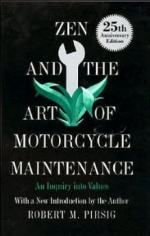
|
| Name: _________________________ | Period: ___________________ |
This test consists of 5 multiple choice questions, 5 short answer questions, and 10 short essay questions.
Multiple Choice Questions
1. Unpacking at the campground is difficult due to
(a) the flashlight's disappearance.
(b) the lack of help from Chris.
(c) the extreme exhaustion of the group.
(d) Sylvia's complaining.
2. DeWeese had not like the "Church of Minorities" because
(a) it was a print of a painting.
(b) it was not abstract.
(c) it was not a very good painting.
(d) it was by an unknown artist.
3. Phaedrus did not like Yellowstone Park because
(a) people in the park acted like animals on display.
(b) the park rangers wore Smokey Bear hats.
(c) the atmosphere of the park made people fake friendliness.
(d) the tourists had white legs sticking out of shorts.
4. John and Sylvia intensified their suffering by
(a) focusing on the heat.
(b) thinking about Phaedrus.
(c) worrying about Chris.
(d) fighting with the Narrator.
5. The Narrator says that some cultures believe in ghosts in the same way that other cultures
(a) believe in eye contact.
(b) believe the earth is round.
(c) believe in the law of gravity.
(d) believe in evil spirits.
Short Answer Questions
1. The Narrator feels apprehensive about
2. The Narrator calls unnatural the divorce of
3. Phaedrus' academic goal in University was to
4. The plans of Chris and the Narrator are deliberately indefinite so that
5. In trying to explain what is wrong with the outdoor barbecue instructions, the Narrator expounds upon what is wrong with technology, which he says is
Short Essay Questions
1. What aspects of teaching were frustrating for Phaedrus?
2. What does the last sentence of the chapter mean: "I am a pioneer now, looking onto a promised land."
3. Why did John and Sylvia get angry with the Narrator?
4. In what ways is Chris a reflection of, or mirror of, his father? How does his father realize this?
5. Summarize how Poincaré's ideas fit closely to Phaedrus' ideas--like two sides of a jigsaw puzzle.
6. How are the people's faces in the cities different from the people's faces in the rural areas? What is the cause of the difference?
7. Based on what you have read through chapter 28, by way of predicting an outcome for the book, write a paragraph or two explaining a dream you think the Narrator will have near the end of the book.
8. How did the mechanics who had worked on the Narrator's motorcycle prove that caring about what you are doing is essential to doing it right?
9. What is the difference between "What's new?" and "What is best?" What type of answer might you get to each question? Which question would you prefer to ask your friends? Which question would you rather have people ask you?
10. How are the tasks that the Narrator and Chris perform related to the discourse of this chapter?
|
This section contains 2,009 words (approx. 7 pages at 300 words per page) |

|




